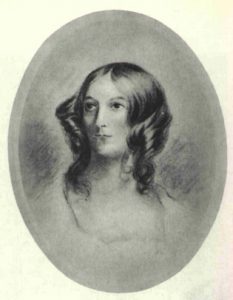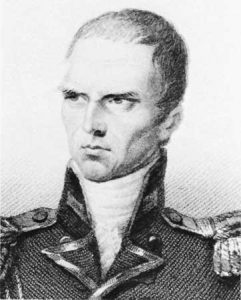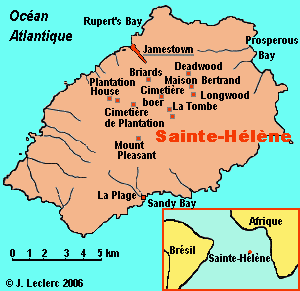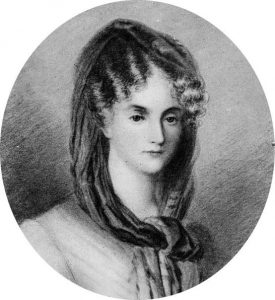Michael Sibalis
Wilfrid Laurier University
 Reacting to news of Thomas Keneally’s most recent novel, Napoleon’s Last Island – the latest of thirty-four! – one exasperated contributor to a leading online forum dedicated to Napoleon and his times (Napoleon-Series.org) commented (26 January 2016): “Not again! Betsy Balcombe has been literally done to death. What else is there left to say???” Thomas Keneally had apparently never heard of Betsy Balcombe before 2012, when he visited the “Napoleon: Revolution to Empire” exhibit at the National Gallery of Victoria in Melbourne, Australia. The exhibition included a number of Napoleonic relics that had once belonged to Betsy and her family, who settled in Australia in 1824 after several years on the island of St. Helena. Keneally is no historian, as he readily admits, but rather “a novelist who nicks stories from history” [1] and here he immediately saw a great story for him to nick.
Reacting to news of Thomas Keneally’s most recent novel, Napoleon’s Last Island – the latest of thirty-four! – one exasperated contributor to a leading online forum dedicated to Napoleon and his times (Napoleon-Series.org) commented (26 January 2016): “Not again! Betsy Balcombe has been literally done to death. What else is there left to say???” Thomas Keneally had apparently never heard of Betsy Balcombe before 2012, when he visited the “Napoleon: Revolution to Empire” exhibit at the National Gallery of Victoria in Melbourne, Australia. The exhibition included a number of Napoleonic relics that had once belonged to Betsy and her family, who settled in Australia in 1824 after several years on the island of St. Helena. Keneally is no historian, as he readily admits, but rather “a novelist who nicks stories from history” [1] and here he immediately saw a great story for him to nick.
Lucia Elizabeth (“Betsy”) Balcombe (1802–1871), the narrator and protagonist of Napoleon’s Last Island, is a very real albeit minor historical figure, known to posterity only because of her brief friendship with one of history’s giants. Betsy’s father was working for the East India Company on St. Helena when the British authorities appointed him provedore to Napoleon and his entourage. For twenty-eight months, from the emperor’s arrival on the island in October 1815 until the Balcombe family left for England in February 1818, the young teenager saw a great deal of Napoleon, especially during his first eight weeks on St. Helena, when he lodged in a small summerhouse on the lawn of The Briars (the family residence) while Longwood House, his permanent residence, was being readied for him.[2]
Napoleon befriended the whole Balcombe family – quite possibly out of political calculation rather than sentiment [3] – but thirteen-year-old Betsy (who spoke French) was his clear favorite. Pretty, feisty, and outspoken to the point of impudence, Betsy was not the sort of girl to be intimidated by a former emperor. They played games, took (chaperoned) walks, and bantered freely, their mutual teasing sometimes taking a cruel turn. For example, when Betsy snatched up a sword and waved it threateningly in Napoleon’s direction or when Napoleon hid Betsy’s ball gown and reduced her to tears by refusing to give it back. Napoleon’s courtiers who shared his exile were appalled by Betsy’s lack of respect for their idol and jealous of the favor he nonetheless showed her. Count de Montholon wrote that Betsy, “who was very pretty, and even more mischievous than beautiful, felt that she could do anything and say anything with impunity, and had all the boldness of a spoiled child.”[4] Countess de Montholon remarked even more bluntly that “[r]aised like a little savage, [Betsy] knew nothing of the ways of the world and was as much at ease with the Emperor as with the lowliest officer on the island, blathering on without the least timidity. Her thoughtlessness and vivacity very much amused the Emperor.”[5] Was there perhaps a muted sexual undertone to the friendship? Julia Blackburn apparently thinks so. She has described Betsy as “cling[ing] on to the amphibious state between childhood and womanhood, which allows her to be bad-mannered and rough, while keeping an edge of flirtatiousness.”[6] Most historians of Napoleon’s years in exile have found Betsy’s cheekiness delightfully engaging, but Michel Dancoisne-Martineau, former French consul on St. Helena, has recently painted a rather unflattering portrait of a girl who sought to make herself the centre of attention by entertaining her fellow islanders with boastful, exaggerated, and sometimes invented tales of her adventures with Napoleon.[7]
Betsy published her own memoirs, which many (including Keneally) inaccurately describe as a “journal” or “diary,” in a series of articles in New Century Magazine in 1843 and in book form the following year. Frequently republished in English and French, the memoirs are still in print.[8] Betsy herself regretted that she “did not keep a journal of all that occurred,” trusting to a memory that had to some extent failed her by the 1840s, but many incidents “[she] did write down shortly after they occurred, and the others have been kept fresh in [her] memory by being repeated to friends.”[9] In the 1960s, her great-niece Mabel Brookes used “Betsy’s brief notes” (which she misleadingly refers to as “old diaries”) to write a lively account of Napoleon’s time on St. Helena.[10] These notes apparently still exist, but their whereabouts are a mystery.[11] Anne Whitehead, Betsy’s biographer, quite rightly doubts the accuracy of many of Betsy’s tales: “one cannot always credit the authenticity of conversations we are told [Napoleon] had with Betsy.” In addition, she suggests, when writing up her memories in the early 1840s, “ideas came to her that could have, might have, should have happened, they were such good stories, why not put them in?”[12]
Whether accurate or not, Betsy’s memoirs have inspired several writers before Keneally. There are at least three previous novels about Betsy in English. Thomas Costain (1885–1965), who published a dozen historical novels, wrote his last one about Napoleon and Betsy. Two other novels were intended for young readers, the most recent of these by Staton Rabin (1958–) in 2004.[13] There has been talk for some years about a movie based on Rabin’s novel, reportedly with Al Pacino as Napoleon and Dakota Fanning as Betsy. This would not be the first movie to tackle the subject. Eagle in a Cage (1972) presents Betsy as a sullen and oversexed sixteen-year-old who seduces the Emperor for her own amusement. In Monsieur N (2003), a sweetly innocent Betsy falls sincerely in love with Napoleon; after the emperor’s escape from St. Helena (his valet Cipriani assuming his master’s place), the couple manages to live in blissful anonymity on a plantation in Louisiana.
Unlike these earlier versions of Betsy’s and Napoleon’s story, Napoleon’s Last Island is narrated by Betsy in the first person. Some readers, however, may find that Keneally’s Betsy is never entirely believable. It’s not that she differs so much from the historic Betsy – smarter, intellectually quicker, and a keener and more knowing observer with sharp psychological insights into the people around her – it’s that she doesn’t behave or write quite like a Regency girl or an early Victorian woman (although some would disagree with this assessment).[14] The novel takes the form of Betsy’s “secret journal, the one hidden behind the real one” (viii), which tells many of the same tales as the actual published memoirs, but in greater (imagined) detail. It also recounts incidents that never really occurred. Keneally admits in his introduction that his novel “plays fast and loose with the strict historical chronology” and “makes guesses, even wild guesses” about what in fact happened on St. Helena, but he asserts his intention “to tell the truth by telling lies” (viii).[15]
As the title implies, Napoleon’s Last Island is as much about Napoleon and St. Helena as about Betsy herself. The reader sees events on the island entirely from Betsy’s point of view. She recounts her growing friendship with the emperor over two and a half years, as she also matures into a young woman, enters the social world of the colony, and flirts with the young officers garrisoned there. She expresses strong sympathies for Napoleon whom she witnessed chafing under British regulations, clashing with the authorities – especially Sir Hudson Lowe, the island’s governor, once he arrived in April 1816 – and gradually winning over a few of the locals, including Betsy’s father, to his cause. Lowe is the villain of the piece, as he is in most historical accounts of Napoleon’s St. Helena years. Lowe’s job was to keep Napoleon from escaping the island or even communicating with his partisans in Europe and America. This meant enforcing the strict restrictions laid down by London, along with other petty rules of Lowe’s own devising. Fictional Betsy describes the governor as a man “with a crooked purpose and a fraudulent sweetness of manner” who “poisoned the earth with his tread” (243) and dubs him “Name and Nature” because she judged him “Lowe by name and Lowe by nature” (270). (The real Betsy had the same poor opinion of the governor.) “It would come to be argued,” Betsy comments, “[…] that the Emperor was as narrow-minded as Sir Hudson Lowe. But he did not have power to impose his conditions upon Sir Hudson, and the small man was making the great man dance to his tune, and a very poor and rough and niggardly tune it increasingly became” (270). Only years later would fictional Betsy come to realize that Napoleon’s jailor was quite simply overwhelmed by his assignment: “We understood nothing of his fear and his monomania. We understood that he was prepared to be inhuman and saw denial as a duty. Only at this distance of time and place do I feel almost sorry for the anguish these possessions evoked in Name and Nature, the way they rankled and bespoke the bigger world’s unwillingness to forswear severity against the Ogre” (280).
Keneally has obviously consulted many of the memoirs written by those who knew or came into contact with Napoleon on St. Helena. The novel offers brief but perceptive (and often very funny) character sketches of many of the French and British personalities on the island, such as this one of Lady Lowe: “Hers was exactly the remoteness of the chronic tippler always absent through calming dosages of […] all-day sherry” (254). He does an excellent job of conveying the oppressive atmosphere on an island where “suspicion pervaded all” (294). St. Helena is rife with plots and intrigues, as Napoleon seeks to defy and undermine Sir Hudson Lowe, to smuggle out uncensored letters to his followers in Europe and America, to win over public opinion both on the island and abroad, and one way or the other to get the British government to bring him to England. “Everyone on the island,” opines Betsy’s father, “is playing their own game and even two games at once” (328). (Indeed, the fictional William Balcombe betrays his own government by secretly working on Napoleon’s behalf, as the historic one actually did.) St. Helena under Hudson Lowe becomes a miniature police state. “Everyone on this island,” comments William Balcombe, “is reported upon” (367). In fact, it turns out in the novel that Mrs. Balcombe herself has been spying on her husband for the governor! Much of the novel, then, is about the effect that Napoleon has on the island and the islanders, especially but not only on Betsy.
Keneally remarked in an interview that he is “fascinated by the idea of ordinary people getting too close to a great flame,” by which he of course meant Napoleon.[16] As Betsy’s father tells her, “You must live in the shadow of this great thing that has befallen us. You must live on when Our Great Friend is vanished, when I am vanished, when the island is behind you. But these events will never leave you!” (185). For the historic Betsy, living in the shadow of Napoleon meant no more than being forever afterwards pointed out as the girl who had once played with an emperor. For the fictional Betsy, however, it means a loss of childhood innocence and a growing awareness of the world’s complexities and cruelties. The culminating (fictional) incident in this process is so grotesque that it is likely to ruin the novel for many readers. (SPOILER ALERT!) Betsy unexpectedly enters Longwood House, opens a closed but unlocked door, and stumbles upon a sexual orgy: “The Emperor, wearing a splendid green dress, […] had his arm companionably around a naked Surgeon O’Meara. […] On his farther side sat my mother, whom he was kissing. […] Looking on from a straight-backed chair, legs apart, […] was the utterly naked Madame de Montholon” (349–350).[17] A shocked Betsy – “[o]n this island of rats and goats, the Emperor and my mother had joined the beasts” (352) – immediately attempts suicide by swallowing rat poison. She fails, and Madame Bertrand advises her that she is now an adult: “What you saw is not a cause to take some nasty rat powder. It is the onset of wisdom” (359). The scene, which Keneally intends somehow to give insight into Napoleon’s loneliness and desperation and the lengths to which his entourage will go to distract him from his troubles, is both tasteless and ridiculous; after all, effective fiction requires at least some degree of credibility.
Shortly afterwards, Lowe discovers that William Balcombe has been facilitating Napoleon’s clandestine correspondence with Europe and expels the Balcombes from the island in March 1818. The last fifty pages of the novel deal with the family after St. Helena. Considered untrustworthy by the British government, William Balcombe cannot find suitable work until 1823 when he reconciles with Lowe for purely pragmatic reasons and gets an official appointment as Colonial Treasurer of New South Wales in Australia. He dies in Sydney only six years later, “the Emperor’s final fallen soldier” (421). Betsy herself enters into a brief and unhappy marriage, which leaves her with a daughter to sing “childhood’s songs earnestly under the Australian constellations” (422).
Keneally (as we have seen) proposes in his preface to tell the “truth” about St. Helena, but he is unfortunately never clear as to what truth he means. Perhaps he wants to portray the “true” Napoleon. Keneally, although a self-described “Australian bush republican” (vii), finds the emperor “ruthlessly enchanting” (v). But he is neither original nor profound in describing Napoleon as an amalgam of good and evil and a figure of contradictory actions. Napoleon, he once commented in an interview, was a man who “kill[ed] hundreds of thousands,” but there were also “all these goodies [that] came from him,” like his civil code and the abolition of feudalism in Western Europe.[18] He transports such judgments into the novel, where characters describe Napoleon alternatively and alternately as “Our Great Friend” (to his supporters, like the Balcombes) and “The Ogre” (to the British establishment). Napoleon, Betsy says, is a “balance of resentment, playfulness, hubris, humility, curiosity and literary appetite” (124). “These days,” she muses after his death, “I believe the truth of him was that he was a fluid personage, given to depression at one hour, exuberance at another, interested in one soul for an afternoon, indifferent to the destiny of thousands for a day. It was later declared, as I have read, that he kept his populace exhilarated and distracted by this fluidity” (176). Mrs. Balcombe comes to much the same conclusion: “Then my mother counselled herself that she must simply accept him as an unarguable whole, his vanities, his impulses for showing humanity as well as those for making mischief, as the one manifestation, in the way that weather is one and diverse and, above all, changeable by its own inimitable will” (216). Keneally’s final verdict is delivered by Lady Holland when Betsy visits her in London: Napoleon was “a man of the future, a man who foresaw a new Europe and a new humanity, and […] whatever his flaws, as we all have them, […] he envisaged something that stood above our narrow grasp” (386).
In the end, whatever the entertainment value of Napoleon’s Last Island as a work of fiction, it contributes little to our historical understanding of Napoleon as emperor or exile. It is not surprising that so many novelists and historians have been drawn to Napoleon’s life on St. Helena and have written so many books, both fiction and non-fiction, about it. His final six years on St. Helena reveal so much about the underlying character of the man himself – stripped of power and authority, and no longer the awe-inspiring general, first consul or emperor. As a much earlier novel about Napoleon and Betsy put it: “That Napoleon whom Betsy Balcombe knew at The Briars – fun-loving and considerate of those about him – was as truly Napoleon as the man before whom many had trembled – whom his enemies had so criticised – [and] to look at him as his young neighbor looked at him is to understand a little the secret of his influence.”[19]
Thomas Keneally, Napoleon’s Last Island, London: Sceptre, 2015; New York, Atria, 2016.
NOTES
- “Interview: Tom Keneally,” The Sydney Morning Herald (online), 7 November 2013, http://www.smh.com.au/entertainment/books/interview-tom-keneally-20131107-2x4ob.html
- There is a recent study of Betsy and her family: Anne Whitehead, The Emperor’s Shadow: Bonaparte, Betsy and the Balcombes (London: Allen & Unwin, 2015). Whitehead has thoroughly researched her subject and for the first time ever provides a detailed account of the family’s history; unfortunately, there are occasional stumbles because of her weak knowledge of the broader history of Britain and France.
- Whitehead, The Emperor’s Shadow, 49–50, 90–94, argues that Napoleon was well aware of Balcombe family’s connections within the British establishment; he may also have believed the rumors that William Balcombe was the Prince Regent’s illegitimate son.
- Charles-Jean-François-Tristan de Montholon, History of the Captivity of Napoleon at St. Helena, 4 vols. (London: Henry Colburn, 1846–1847), 1:164.
- Journal secret d’Albine de Montholon, maîtresse de Napoléon à Sainte-Hélène, ed. François Candé-Montholon (Paris: Albin Michel, 2002), 110.
- Julia Blackburn, The Emperor’s Last Island: A Journey to St. Helena (New York: Pantheon, 1991), 61.
- Michel Dancoisne-Martineau, “Betsy,” in his Chroniques de Sainte-Hélène, Atlantique sud (Paris: Perrin, 2011), 155–62.
- Elizabeth Abell, Recollections of the Emperor Napoleon during the first three years of his captivity on the island of St. Helena including the time of his residence at her father’s house, “the Briars” (London: John Murray, 1844). The latest editions in English are To befriend an emperor: Betsy Balcombe’s Memoirs of Napleon on St. Helena, intr. David Markham (Welwyn Garden City, UK: Ravenhall Books, 2005) and Napoleon & Betsy: Recollections of the Emperor Napoleon on St. Helena, ed. Allan Sutton (N.p.: Fonthill, 2012).
- Abell, Recollections, 28–29.
- Dame Mabel Brookes, St. Helena Story (NY: Dodd, Mead & Company, 1961). Brookes’s grandfather, Alexander Balcombe, was one of Betsy’s younger brothers.
- According to Blackburn, The Emperor’s Last Island, 70, the so-called diary “has apparently made its way into a collection of papers and documents that lie in the archive department of an art gallery in Melbourne, Australia. It is not a narrative by any means, just a few brief jottings that leap over the months […].” Blackburn provides no source for this information. These notes may be the ones that Betsy dictated to 17-year-old Edward John Eyre on a return voyage to Australia in 1832 (see Whitehead, Emperor’s Shadow, 391-92). My own attempts to locate them have proved fruitless. Many reviewers declare that Keneally used Betsy’s “journals” or “diaries” in writing his novel; in fact, he used her published memoirs, along with other standard sources for the St. Helena period of Napoleon’s life.
- Whitehead, Emperor’s Shadow, 67, 401.
- Thomas B. Costain, The Last Love (New York: Doubleday, 1963); Helen Leah Reed, Napoleon’s Young Neighbor (Boston: Little, Brown and Co., 1907); Staton Rabin, Betsy and the Emperor (New York: Simon & Schuster, 2004).
- For example, Nick Curtis, wrote in The Evening Standard that Keneally “imagines himself convincingly into the mind of an English girl from the ages of 13 to 21.” See his review of 19 May 2016, http://www.standard.co.uk/lifestyle/books/napoleon-s-last-island-by-thomas-keneally-review-a3252571.html.
- In his preface to Shame and the Captives (New York: Atria Books, 2015), p. xi, Keneally similarly wrote: “Fiction has always tried to tell the truth by telling lies, by fabrication.”
- “Tom Keneally on Napoleon’s Last Island” (interview), Booktopia TV, https://www.youtube.com/watch?v=TmyyyHfDNTw.
- In his “final notes,” Keneally proffers a half-hearted apology: “Mrs Balcombe and […] Surgeon O’Meara may have been defamed, in which case I can merely apologise to a fine woman and to the others” (424).
- Interview with Thomas Keneally on ABC (Australian Broadcasting Corporation) radio, 16 November 2015, online at http://www.abc.net.au/radionational/programs/booksandarts/napoleon’s-last-island/6938998.
- Reed, Napoleon’s Young Neighbor, 267.








